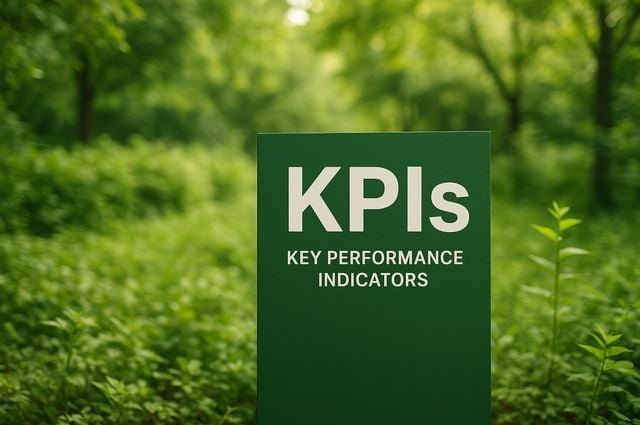To KPI or Not to KPI?: Revisiting Sustainability Metrics in Hospitality
14 experts shared their view
The hospitality industry loves a good Key Performance Indicator (KPI). A quick search reveals the sector's holy grail of metrics: ADR, Occ%, RevPAR, GOPPAR, TRevPAR—numbers that obsess over revenue but say nothing about the health of our planet, the well-being of our workforce, or the resilience of the communities we operate in.
Dig deeper, and yes, sustainability KPIs do exist: carbon per occupied room, waste diversion rates, local sourcing percentages. The industry has embraced them as proof of progress. But as the climate crisis accelerates [1] and ecosystems collapse [2], we must ask: Are KPIs masking deeper systemic failures?
Metrics matter. But when sustainability becomes a box-ticking exercise—another ceremonial annual report—we risk missing the point entirely. Consider:
- A hotel celebrates "20% energy reduction" while expanding its square footage, leaving total consumption higher than ever.
- A new building boasts "high energy efficiency" while ignoring the colossal embodied carbon of its construction.
- A "zero-waste" certification overlooks the deforestation and water scarcity embedded in its supply chain.
KPIs often measure efficiency but often ignore absolute impact.
This is the KPI Paradox in Hospitality: metrics designed to reassure managers, investors and regulators, but possibly without driving the needed transformation. KPIs are not the enemy to sustainability progress—but they are not the saviour either.
To move beyond this paradox, we need a frank discussion:
- Reframing the KPI Mindset: How do we shift from "Did we hit our target?" to "Did this metric actually change anything?
- When KPIs Backfire: Can you share an example where KPIs created a false sense of sustainability progress or even backfired?
- Beyond KPIs: Alternative Approaches: What alternative approaches could complement, enhance or perhaps replace traditional KPIs?
- Your Top 3 Sustainable Hospitality KPIs: If you could mandate only three metrics for the sector, what would they be—and why?
References
[1] Hansen, J. E., Kharecha, P., Sato, M., Tselioudis, G., Kelly, J., Bauer, S. E., … Pokela, A. (2025). Global Warming Has Accelerated: Are the United Nations and the Public Well-Informed? Environment: Science and Policy for Sustainable Development, 67(1), 6-44. https://doi.org/10.1080/00139157.2025.2434494
[2] Gross, M. (2023). When ecosystems collapse. Current Biology, 33(2), https://doi.org/10.1016/j.cub.2023.01.001.
Hotels have focused their attention on utility-related metrics. As a result, the measurement of hotel consumption data and KPIs feels like a tick-box exercise. However, when it comes to social metrics—such as well-being, employee retention, education, human rights, or the suppliers audited to ensure compliance with the company's code of conduct—these indicators are crucial. Social impact has historically been one of the hardest areas the industry began to measure, which is why many hotels still lack robust data and KPIs in this area. Often, the focus is placed solely on ROI, rather than KPIs. The relevance of a metric depends on its context. That"s why standards, operational certification schemes, and best practices must incorporate local variables into their measurement methods and data collection formulas. Measuring these aspects is still important—it helps quantify impact and fosters transparency. Transparency allows us to demonstrate data about actions taken, how, when and why. Measurement itself is not the end goal; it is a means to ensure that action plans are effectively carried out. Without proper contextual and location-based data, figures are misleading. To make metrics meaningful is through accountability and context. In this regard, context is the foundation of continuous improvement.
Over the last 15 years we’ve learned that metrics can help, but only when rooted in purpose. At The Long Run, we work with nature-based tourism businesses around the world to embed sustainability through our holistic 4Cs framework: Conservation, Community, Culture, and Commerce. This means KPIs alone will never be enough. What matters is not whether you hit a number, but whether the number moves us closer to the future we want.
Reframing the KPI Mindset
We believe KPIs should emerge from a long-term aspiration, not just operational convenience. Before any metrics are set, we encourage members to ask: Why are we doing this? What change are we seeking in the world? Only then can the right building blocks, and the right indicators, be put in place.
Crucially, many aspects of sustainability aren’t easily quantifiable. So, we work with members to combine qualitative and quantitative metrics and contextualise results. For example, treating 800 people through a dental programme is not impactful unless we understand who was reached, what proportion of the community that represents, and whether health outcomes improved over time.
When KPIs Backfire
While we haven’t catalogued specific examples of KPIs backfiring, we often encounter metrics that create a false sense of progress. Reporting high renewable energy usage, for instance, might ignore the embodied carbon of construction. Or boasting about staff training numbers may overlook whether those skills translate into long-term benefits.
Beyond KPIs: Complementary Approaches
For The Long Run, it’s always been about impact first. Our Global Ecosphere Retreat® standard focuses not on efficiency alone, but on meaningful, context-specific change. We prioritise evidence of progress toward a goal, like energy self-sufficiency, rather than just hitting a numerical target.
We also believe storytelling is key. Data without narrative is hollow. It matters what you measure, but also how you communicate its significance, to your team, guests, investors, and local communities.
Top 3 Sustainable Hospitality KPIs
If we had to choose only three KPIs to mandate across the sector, they would be:
- Percentage of staff paid above a living wage – because fair pay underpins dignity and social wellbeing.
- Percentage of revenue reinvested into Conservation, Community, and Culture – to ensure businesses contribute beyond their operational boundaries.
- Longitudinal community transformation – qualitative, evidence-based stories that demonstrate sustained impact over 3, 5 or even 10 years.
Conclusion
KPIs can help, but only when they're in service of something deeper. At The Long Run, we see them as one piece of a larger puzzle: a roadmap guided by values, context, and the desire for long-term impact. Metrics should not just prove we’ve done something, they should help us understand if we’re doing the right thing and empower us to pivot if we need to.
KPIs are useful, because they allow us to compare. A hotel knowing that another one is far more efficient will eventually strive to understand why this is the case. This should become increasingly relevant as energy or food prices go up. However, this presupposes that measurement standards are comparable and that they are also known. In a country like Turkey, where all hotels have to go through certification, this is a given, in most other countries, it is not. We also need to agree on indicators that are meaningful. All companies need to move to net-zero, for example. The relevant indicator here is not how much more efficient a hotel has become per unit of expenditure, per guest or per room - we need to know by how much emissions were cut from total amounts, year-on-year. Specifically for larger firms, this will likely imply that owners/managers/boards will realise that continued growth and decarbonisation cannot be reconciled.
At Kerten Hospitality, sustainability isn’t a trend, it’s our core ethos. Through UBBU (United Building a Better Universe), our ESG framework, we go beyond compliance to drive meaningful impact in our communities and operations. While KPIs provide structure, they can also limit vision. That’s why we focus on purposeful measurement, reframing success through outcomes that matter.
Reframing KPIs for Impact
We’ve moved from performance for its own sake to impact with intention. Instead of asking, “Did we meet the KPI?” we ask, “Did it create positive change?” KPIs should activate progress, not just track activity.
When KPIs Backfire
We once hit a local sourcing target, only to find the vendors were national chains, not part of the local community. The metric was met, but the locality principle wasn’t. This highlights how unchecked KPIs can obscure true impact.
Our Top 3 UBBU KPIs
- Regenerative Impact Score – Tracks how we actively regenerate ecosystems and communities.
- Community Wealth Circulation Rate – Measures local economic impact of each property to micro-suppliers, farmers and artisans.
- Purpose-Led Engagement Index – Gauges how connected and empowered our teams feel about ESG goals.
The real problem in real estate and hospitality isn't a lack of KPIs, it's a failure of decision logic. KPIs are outputs, not levers. What really drives value is the sequencing of decisions and interventions, yet today's asset upgrade processes remain fragmented, manual, and out of sync with evolving science-based targets and regulation. Misapplied KPIs and outdated certifications can create a false sense of progress, as shown by clients who once celebrated high ratings like BREEAM Excellent, only to later face non-compliance and costly retrofits. These failures aren't due to bad metrics, but due to systems that lack integrated, forward-looking logic. SustainCRE addresses this by codifying the upstream workflows, much like a self-driving car determines and recalibrates its route. The result isn't just better KPIs, it's faster, cheaper, more precise upgrades with tangible returns. The real question isn't which KPIs matter, but whether your system can produce KPIs that matter at all.
Related article by Lucienne Mosquera
KPIs are useful tools for tracking sustainability progress in the hospitality sector—but only when understood in context. For example, a metric like emissions per guest night can indicate a level of energy efficiency. But on its own, it doesn't reveal the total environmental impact, vulnerability to climate risks, or the strain placed on local resources.
The industry needs to shift from simply asking "Did we hit the target?" to "Did this action improve local community resilience?" This means complementing KPIs with indicators that reflect systemic risks, climate realities, and social and environmental justice.
KPIs therefore need to be interpreted together with local context, such as:
- total environmental impact
- vulnerability to climate risks
- strain placed on local resources
- local community resilience
Important KPIs such as emissions per guest night, water use, and the percentage of local suppliers should be contextualized with information on location-specific climate risks, regional water stress, and the capacity of local supply chains. In isolation, KPIs can become checkboxes but when used with intention and supported by contextual assessments, they can be powerful tools for driving genuine progress.
Share price and value are correlated to current and expected future profits, which can depend on decisions from governments with short term priorities who legislate for GDP growth as a solution to most of their problems. We should be pushing for a lasting global commitment to change the collective vision of success, and to accept that success shouldn't be measured in purely economic terms. GDP as the main economic KPI must be re-defined to make progress towards a sustainable future. Business leaders need KPIs, but in a flawed economic system the wrong KPIs will propagate the wrong results.
Hospitality business leaders working within this system find it challenging to determine and balance the "ESG" impact of every decision. We therefore need a collaborative effort to help each stakeholder develop and improve relevant KPIs in their areas of focus, to do less harm.
KPIs should drive incremental improvements: reduced consumption and/or waste; increased circularity; biodiversity; stakeholder buy-in and wellbeing; and contribute to a more regenerative, financially sustainable hospitality business. Until governments step in, the choice of which KPIs to focus on will depend on your materiality analysis, and your business goals (financial and other) or those mandated by a certification.
What do KPIs, certificates, and ESG ratings have in common?
They're all tools we use to measure impact and performance. But can one metric, or even one system, capture everything at once? Probably not. As we navigate ESG reporting, the challenge isn't just what to measure, but how much, how specifically, and how meaningfully.
Related article by Melinda Ratkai
Rather than reframing our mindset we need to start championing those that have the courage to measure, and disclose, and working with them to build complimentary approaches that make a meaningful impact.
Let's take a step back and question why the sector's holy grail of metrics are ADR, Occ%, RevPAR, GOPPAR, TRevPAR – because that's what we are educated to measure and that's what we are compared against. Where is the education or support to explore new measures or to consider more than just the basics? Where is the support to upskill those that were educated decades ago when our priorities were different? The fragmentation of the sector and competing voices urging us to measure various aspects in various ways does not support a drive towards measurement that will make a change.
Leadership is needed to support the shift. Leadership from the academic community to provide a suite of measures that can align to a holistic view of sustainable outcomes. Leadership from Government to move beyond growth measures as the definition of success. And leadership from businesses that have been doing this for decades to support other businesses in building a more rounded approach to measurement.
While we are still trying to mainstream KPIs for sustainability and harmonize the metrics, the deeper question of metrics making a difference does need to be asked. While sustainability platforms and certifications are commendable, the spreadsheet can become the goal. Most are points systems, so a company can choose to divert 50% more of its waste away from landfills, report scope 1, 2, and 3 emissions and set reduction targets, but they might not choose to pay a living wage, also worth points on the spreadsheet. They might "game" the spreadsheet and go after high point earning categories and ignore others altogether. Luckily, many reputable certifications demand increased performance once on the platform, such as B Corps, but there are still places to hide unsustainable practices. Can we achieve an absolute positive impact score? There are a few points where impact comes together: 1) a local support score that amalgamates hiring local workers, sourcing local food and products, giving back to local communities, and supporting cultures; 2) a regeneration of the environment score quantifying ecosystem restoration; and 3) a worker and community happiness score riffing off of Bhutan's idea of replacing Gross Domestic Product with Gross National Happiness.
Sustainability is a broad subject, but the climate crisis is clearly its most urgent and critical component. As such, the top KPI needs to be related to carbon - and, to remove differences in carbon intensity, energy.
New build is a whole different animal, where embodied carbon indeed needs to be accounted for. However, for operational hotels, Energy Use Intensity (EUI) is the most relevant one as it looks at efficiency of energy use and allows us for comparative analysis on an area basis.
This should be shown alongside energy use per available room and per guest night. Each of those metrics will have its use dependent on the type and purpose of the analysis.
Top 3 Sustainable Hospitality KPIs
The European Green Deal is a proactive and necessary goal towards a lasting transition to a greener future, but the EU is being followed modestly by other economic powers and regions. Imposing strict KPIs on hotels may not result in a sustainable and competitive business environment. Hotels are finding it difficult to implement significant technological innovations in an increasingly stressful environment where the paradox of sustained quality service and improved financial results must coexist while significant investments are needed. I believe that hotels should focus on basic yet key KPIs such as maximizing renewable energy sources, developing food networks that are as locally sourced as possible, and actively involving (encouraging) guests in sustainable initiatives. Of course, clear and business-friendly policy support is also essential, with financial incentives such as tax breaks to encourage such a shift. In short, I firmly believe that widespread KPIs make life for hoteliers rather complicated, so why not focus globally on the main challenges that have a significant and concrete impact in the near future.
In sustainable hospitality, metrics matter—but only if they measure what truly drives impact. Too often, KPIs focus on surface-level achievements that don't reflect real change. This article calls for a shift in mindset: from asking "Did we hit our target?" to "Did this metric actually move the needle—for our people, our planet, and our business?"
Certification alone isn't enough. Without leadership accountability and guest alignment, even the most polished sustainability programs can fall flat. To create real progress, we must tie metrics to financial incentives, long-term operations, and emotional resonance with guests.
But individual hotels can't do it alone. True sustainability requires destination-level collaboration. When hotels and communities work together, shared success becomes inevitable—and measurable.
This piece explores alternative approaches to traditional KPIs, including guest sentiment tracking, third-party conservation partnerships, and upcycling initiatives that create circular economies and local jobs. If we want to future-proof hospitality, we must evolve our metrics from compliance checklists to catalysts for change.
The message is clear: what we measure matters. But even more important is why we're measuring—and who benefits when we get it right.
“Diddling with the details, arranging the deck chairs on the Titanic” [1] -Donella Meadows
Leverage Points: Where Metrics Fail and Systems Thrive
I will use Donella Meadows’ work on Leverage Points [1] to explain some of the issues with hospitality’s sustainability KPIs.
Pushing levers at the lowest levels of systemic power
Many sustainability metrics operate at the lowest levels of systemic power: parameters and numbers. These are easily gamed (see Goodhart’s Law) and often ignore critical interdependencies (e.g., a “zero-waste to landfill” hotel sourcing from food from distant, deforested regions). This demonstrates how a narrow KPI can obscure the larger systemic picture. We’ve seen this problem in action with the many issues pertaining to achieving "carbon neutrality" through offsets already [2].
To complement or enhance traditional KPIs, we need approaches that consider higher leverage points:
Considering the higher leverage [see 1]
- Feedback Loops:
- Instead of just reporting, implement systems where negative impacts trigger corrective action. If any consumption KPI spikes, automatically initiate a review of usage patterns and implement corrective measures.
- Goals:
- The hospitality sector’s goal remains growth with pipeline reaching historic levels [2], not regeneration. A hotel tracking "biodiversity net gain" (focused on ecosystem health) offers a stark contrast to one solely focused on "occupancy rates" (focused on extraction).
- Paradigms:
- Challenge the underlying belief that nature is merely a resource. Metrics should reflect interdependence. Consider measuring "local community well-being" or "ecosystem health of surrounding areas" rather than just "guest satisfaction scores" or "revenue per available room."
Mandating only 3 KPIs – not easy…
- Local Ecosystem Health & Regeneration Index: This would go beyond simple impact reduction to measuring active contributions to biodiversity, soil health, and water quality in the surrounding environment. It addresses the "Paradigm" leverage point.
- Circular Resource Flow Rate: This metric would track the percentage of materials used that are truly circular (reused, recycled, or composted locally) and the reduction in virgin material input, moving beyond just "waste diverted from landfill." This speaks to "Feedback Loops" and resource efficiency.
- Community & Employee Well-being Index: This would holistically assess the positive social impact on local communities and the well-being of staff, considering factors like fair wages, local employment, and cultural preservation. This elevates the "Goals" of the business beyond purely financial ones.
Ultimately, the real leverage lies not in better metrics, but in metrics that make ‘better’ obsolete.
References:
[1] Meadows, D. (1999). Leverage Points: Places to Intervene in a System. The Sustainability Institute, p. 6. https://donellameadows.org/wp-content/userfiles/Leverage_Points.pdf[2] New Climate Institute. (2024). Joint Statement: Why carbon offsetting undermines climate targets. https://newclimate.org/news/joint-statement-why-carbon-offsetting-undermines-climate-targets
[3] Lodging Econometrics. (2025). The Global Hotel Development Pipeline Reaches Historic Milestone with over 15,800 Projects at Q4 2024 Close. https://lodgingeconometrics.com/global-hotel-development-pipeline-reaches-historic-milestone/














